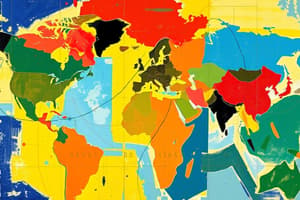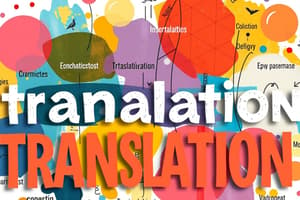Podcast
Questions and Answers
Which term describes the original text in the context of translation?
Which term describes the original text in the context of translation?
- Target Text
- Contextual Text
- Interpreted Text
- Source Text (correct)
What distinguishes interpreting from translation?
What distinguishes interpreting from translation?
- Interpreting is less demanding than translation.
- Interpreting occurs in real-time settings. (correct)
- Interpreting requires advanced writing skills.
- Interpreting deals with written texts.
What role do personal characteristics play in translation?
What role do personal characteristics play in translation?
- They only affect the interpreter's performance.
- They influence the translation quality and effectiveness. (correct)
- They enhance the translator's technical skills.
- They are irrelevant to the translation process.
Which of the following best defines translation equivalence?
Which of the following best defines translation equivalence?
What term refers to the audience's understanding of a translated text?
What term refers to the audience's understanding of a translated text?
In what context is 'Translation & Media' discussed?
In what context is 'Translation & Media' discussed?
What is a common misconception about the qualifications needed for a translator?
What is a common misconception about the qualifications needed for a translator?
Which factor does NOT contribute to the translation quality?
Which factor does NOT contribute to the translation quality?
Which type of translation involves the oral rendering of a written message?
Which type of translation involves the oral rendering of a written message?
What distinguishes human translation from machine translation?
What distinguishes human translation from machine translation?
Which translation type focuses on converting texts related to law?
Which translation type focuses on converting texts related to law?
What is a common issue faced in translation according to field?
What is a common issue faced in translation according to field?
Which type of translation would you use for a scientific article?
Which type of translation would you use for a scientific article?
What does Nida & Taber emphasize as essential in translation?
What does Nida & Taber emphasize as essential in translation?
Which of the following best describes the view of translation according to Bell?
Which of the following best describes the view of translation according to Bell?
In the context of translation studies, what do ST and TT abbreviate?
In the context of translation studies, what do ST and TT abbreviate?
What is the primary focus of Nord's definition of translation?
What is the primary focus of Nord's definition of translation?
Which characteristic does Stubbs NOT attribute to a 'text' in translation studies?
Which characteristic does Stubbs NOT attribute to a 'text' in translation studies?
Which translation concept relates to the idea of losing meaning in the process of translation?
Which translation concept relates to the idea of losing meaning in the process of translation?
According to Newmark, what is essential for a translation to be deemed adequate?
According to Newmark, what is essential for a translation to be deemed adequate?
Which term does NOT relate to the basic terminology used in translation studies?
Which term does NOT relate to the basic terminology used in translation studies?
What defines the context of a message as per the provided definition?
What defines the context of a message as per the provided definition?
Which of the following best describes a translation problem?
Which of the following best describes a translation problem?
Which term refers to the way a translator renders the meaning of a source text unit?
Which term refers to the way a translator renders the meaning of a source text unit?
What is defined as the degree of similarity between the source text and its translation?
What is defined as the degree of similarity between the source text and its translation?
What does translation loss refer to?
What does translation loss refer to?
Which translation method involves maintaining the same grammatical structure as the source text?
Which translation method involves maintaining the same grammatical structure as the source text?
What aspect is crucial for achieving translation equivalence?
What aspect is crucial for achieving translation equivalence?
In terms of translation classification, which factor is NOT mentioned?
In terms of translation classification, which factor is NOT mentioned?
Study Notes
Introduction to Translation
- Translation encompasses the process of converting text from one language to another while preserving meaning and intent.
- Key players in translation include the author (original creator) and the audience (intended recipients of the text).
Defining Translation
- Numerous definitions exist, highlighting the complexity and subjective nature of translation.
- Key definitions:
- Catford defines it as substituting a text from one language for another.
- Nida & Taber emphasize a natural equivalent in meaning and style.
- Newmark focuses on maintaining author's intended meaning.
- Nord advocates for a functional relationship between source and target texts.
- House stresses pragmatic and semantic equivalence.
Basic Terms in Translation
- Familiarity with abbreviations is essential:
- ST: Source Text
- TT: Target Text
- SL: Source Language
- TL: Target Language
Text and Context
- A text is a structured piece of language, serving a communicative function within its context.
- Context refers to the circumstances and settings surrounding an event or idea, crucial for understanding the message conveyed.
Author and Audience
- Authors are the creators of original texts, while audiences receive and interpret these texts.
- Understanding the dynamic between author and audience is vital for effective translation.
Translation Problems
- Translation challenges may arise from:
- Lexical, grammatical, or cultural differences between SL and TL.
- Stylistic variations and different writing approaches in source texts.
Translation Techniques
- Techniques define how translators convey meaning from source text units, including:
- Free and literal translations.
- Borrowing and functional translations.
Equivalence and Translation Loss
- Equivalence measures the similarity in meaning and message between source and target texts.
- Translation loss accounts for informational or tonal discrepancies due to differing structures or cultural contexts.
Types of Translation
- According to Medium:
- Oral Translation: Spoken message conversion (e.g., interpreting).
- Written Translation: Textual conversions (e.g., documents, books).
- According to Agent:
- Human Translation: Conducted by a human translator.
- Machine Translation: Automated translation via software, generally less accurate than human counterparts.
- According to Field:
- Literary, Technical, Scientific, Legal, Media, Business, Political, and Medical translations, each requiring specialized knowledge and approaches.
Interpreting and Skills
- Interpreting involves oral translation, with methods including simultaneous and consecutive interpretations.
- Interpreters require specific skills and personal attributes to navigate translation effectively across different mediums.
Studying That Suits You
Use AI to generate personalized quizzes and flashcards to suit your learning preferences.
Related Documents
Description
This quiz covers the foundational concepts of translation, including definitions, types, and basic terms used in the field. Designed for students in TRS200, it aims to enhance understanding of essential principles and skills related to translation. Prepare to deepen your knowledge in this critical area of study!




